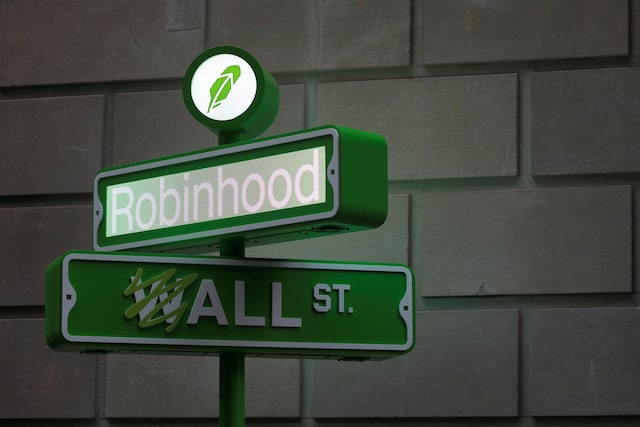The logo of Robinhood Markets, Inc. is seen at a pop-up event on Wall Street after the company’s IPO in New York City, U.S., July 29, 2021. REUTERS
Summary
- Set to offer trading in derivatives for lower fees
- Aim to be primary financial services provider – exec
Oct 16 (Reuters) – Robinhood (HOOD.O), launched its long-awaited desktop platform and added futures and index options trading features to its mobile app on Wednesday, as the fintech firm aims to take market share from traditional brokerages.
The 11-year-old commission-free trading app, which became synonymous with mom-and-pop investors in 2021, is now seeking to mature into a full-fledged financial services provider and compete with established brokerages that serve institutional investors.
The Menlo Park, California-based company said its desktop trading platform, dubbed ‘Robinhood Legend,’ will focus on active traders.
“We’ve matured alongside our customers and have heard loud and clear that they want access to more advanced products and more active trading tools,” Chief Brokerage Officer Steve Quirk told Reuters.
“Our long-term goal is for Robinhood to be the primary financial services company that meets all of customers’ needs.”
The platform, available at no additional cost, will offer advanced trading tools, real-time data, as well as custom and preset layouts.
Meanwhile, the app will allow users to trade futures on the benchmark S&P 500 (.SPX), index, oil and bitcoin , among others.
BATTLE FOR MARKET SHARE
Long dominated by high-profile names like Vanguard, Charles Schwab (SCHW.N), and Fidelity Investments, the U.S. brokerage industry saw its first disruption in decades when pioneered commission-free trading in 2013.
A decade on, Robinhood is expanding to cater to more seasoned investors. Trading in futures and options has typically been the domain of large banks, hedge funds and asset managers, due to higher margin requirements, increased volatility, complexity and commissions.
Subscribers to Robinhood’s premium Gold tier will be able to trade futures for as low as 50 cents per contract, while non-Gold users will need to pay a commission of 75 cents.
This compares with Schwab’s charges of $2.25 per contract, while Morgan Stanley’s (MS.N), E*TRADE takes $1.50 for futures and $2.50 for crypto futures.
Robinhood’s fees for index options, set at 35 cents per contract for Gold members and 50 cents for others, is also lower than industry peers.
The company had 11.8 million monthly active users and 1.98 million premium ‘Gold’ customers, as of June 30.

Analysts have previously said Robinhood’s entry into futures trading this year could be met with some caution by retail traders if it charges a fee, but it could also create new opportunities for expanding its market share.
Earlier this year, the company had committed to expanding margins while focusing on driving “profitable growth” in 2024. Three consecutive quarters of reported profits have also bolstered investor enthusiasm, contributing to a year-to-date stock gain of over 100%.

Reporting by Manya Saini and Niket Nishant in Bengaluru; Editing by Shailesh Kuber





